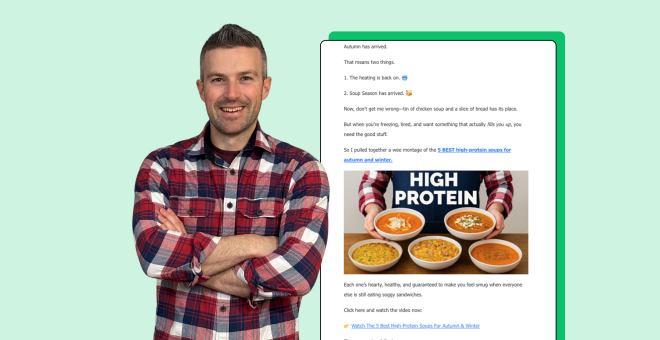Win back inactive subscribers with a re-engagement email campaign
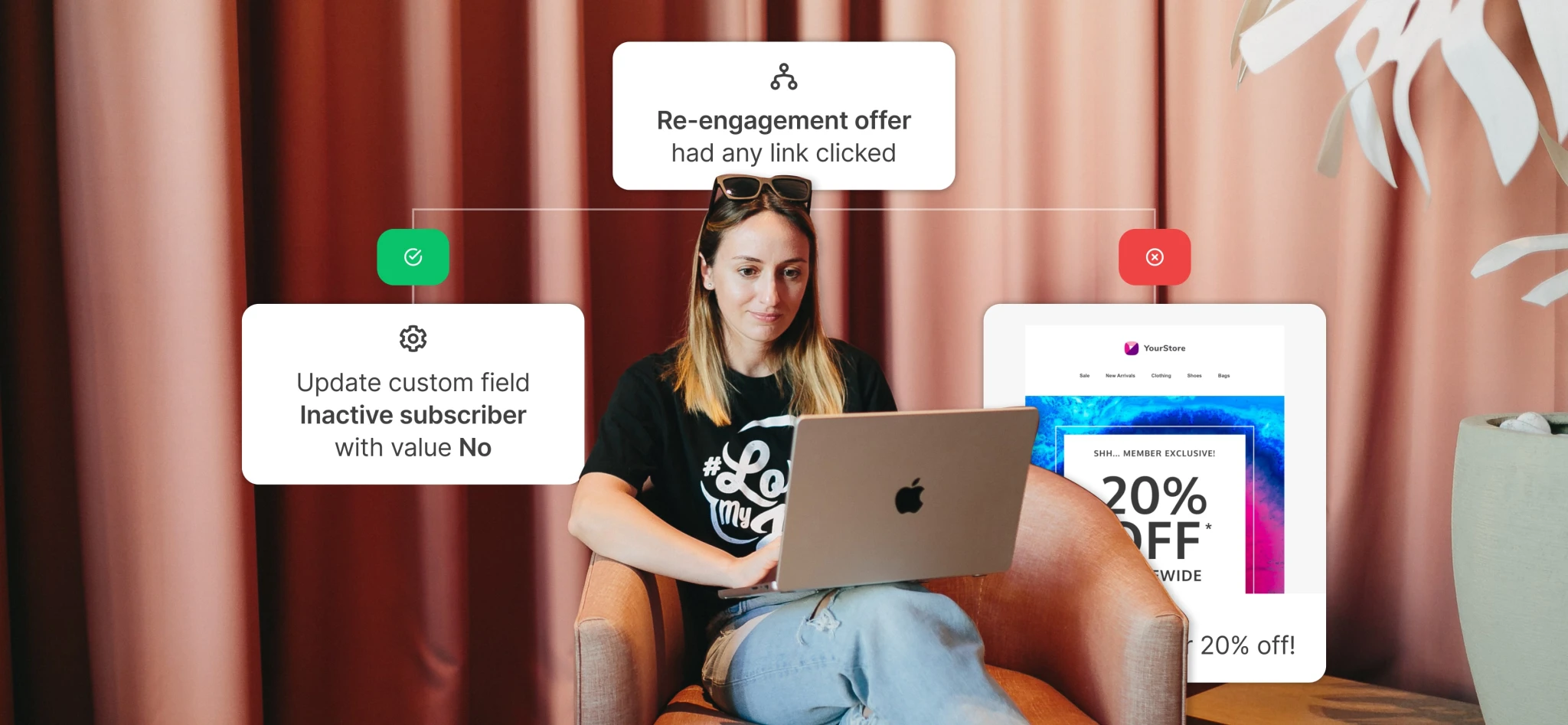 Indrė planning an effective re-engagement campaign.
Indrė planning an effective re-engagement campaign.
If subscribers are ghosting you, it doesn’t mean there’s no hope of salvaging the relationship! They might just need a little extra care and attention to get them re-engaged with your brand.
Over time some of your subscribers will become inactive. These subscribers are not only bad for business, but they can actually hurt your future email marketing performance.
Before you remove them from your list, try sending a win-back email campaign to remind them why they signed up in the first place. It’s easy to do, and you might even turn these people into customers.
In this post, we'll explain why you don’t want inactive users on your list and teach you how to set up an effective re-engagement email campaign with MailerLite.
What is a re-engagement email campaign?
A re-engagement email campaign is a sequence of emails designed to encourage inactive subscribers to interact with your messages. This is achieved through subject lines, offers and content that stands out from your brand’s regular campaigns.
When inactive subscribers interact with your re-engagement campaigns, they are marked as active and remain subscribed to your email list. People who ignore your re-engagement messages are automatically unsubscribed.
It can seem counterintuitive to delete subscribers as you worked so hard to get them. But, people who don’t interact with your emails aren’t providing any value to your brand. They may even be hurting your email marketing efforts—we’ll explain why in the next section.
Ultimately, a re-engagement campaign results in a higher-quality email list filled with people who engage with your messages and your brand.
Why it's important to re-engage inactive customers
Still not convinced why you need re-engagement campaigns? Here are some solid reasons that might convince you to try
Boost customer value and sales: People who read your messages are more likely to buy from your company. When you successfully re-engage a contact, you significantly increase their value to your business.
Increase open and click-through rates: Removing inactive subscribers is an easy way to inflate your metrics. When you delete these people from your list, the percentage of your remaining list who engages with your content will increase.
Improve sender reputation and deliverability: Having a large number of inactive subscribers can reduce your sender reputation and email deliverability. When email providers like Gmail and Outlook see that many people ignore your emails, their filters are more likely to send your messages to spam folders.
You can always clean your list and delete inactive subscribers to avoid these problems. But sending a re-engagement campaign first is a way to get more value from each contact.
Re-engagement email examples to inspire you
Here are some of the most effective types of re-engagement emails you can send. We’ve included plenty of examples from well-known brands for inspiration.
Give discounts to incentivize purchases
Discounts and coupons in email newsletters engage inactive subscribers by giving them an extra incentive to buy from your brand.
Skillshare encourages previous Skillshare Premium users to sign up again with an offer to get the first month for just $0.99. It’s an attractive call-to-action (CTA) considering a subscription is usually over $13 per month.
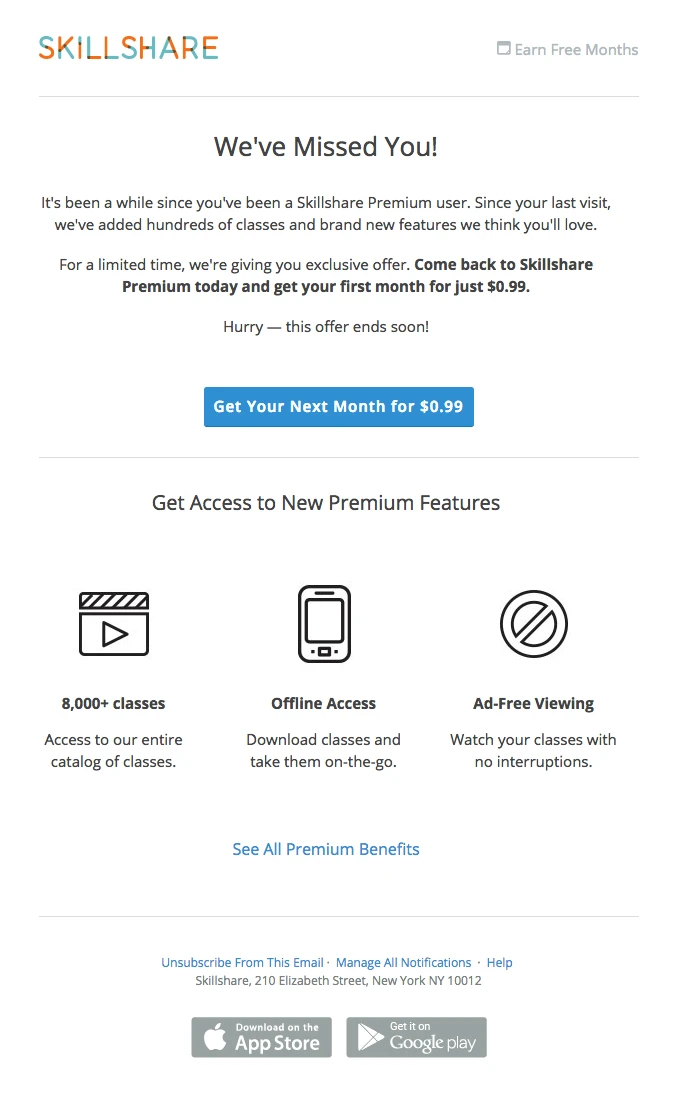
Nordstrom Rack tries to reactivate its email subscribers by offering a $20 discount on their next order. Like the Skillshare offer, this is a significant saving!
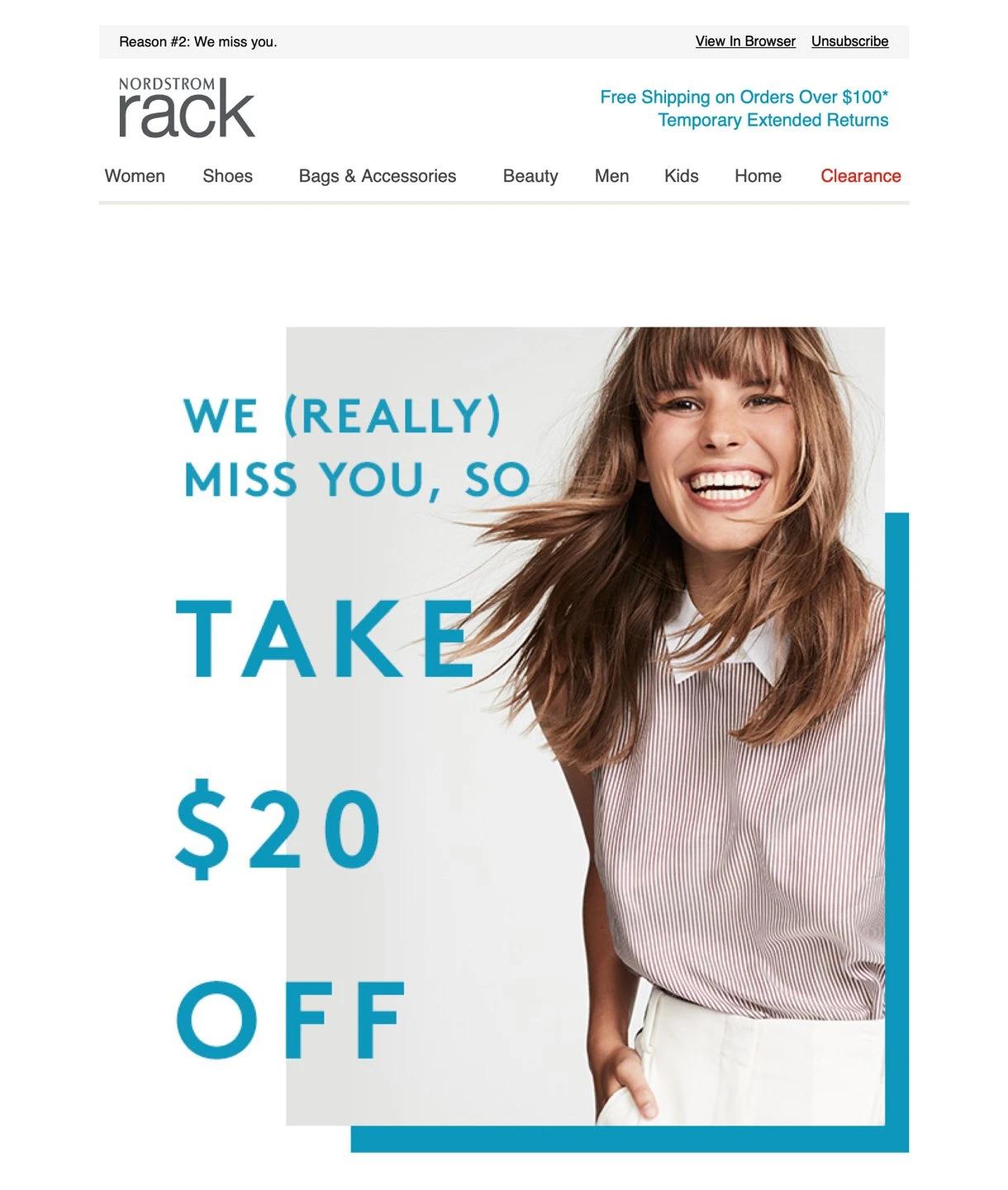
Highlight new ways your product can benefit the subscriber
Focusing on lesser-known product features or benefits can be an effective re-engagement strategy. It works because subscribers learn new ways to use your product that may appeal to them.
In the re-engagement email below, Venmo highlights that users can now pay for Grubhub orders, making it easy for people who use the app to pay for their next food delivery. Subscribers who were unaware of the feature may now have a reason to start using the tool again.
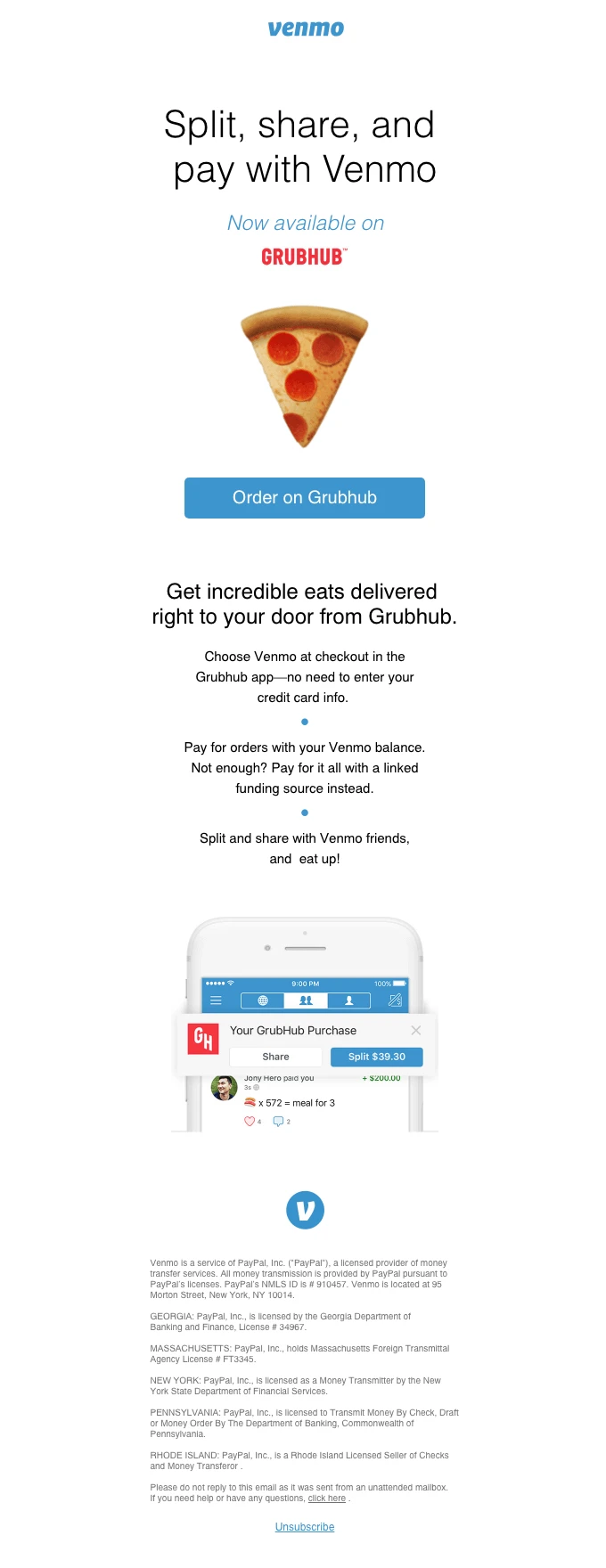
Create your own re-engagement campaign
Sign up for a free account to access all the features you need to re-engage your inactive subscribers and increase the value of your email list.
Show subscribers what they've missed
Use FOMO (fear of missing out) to leverage subscribers' innate desire to be included and avoid missing out on valuable opportunities, such as exclusive deals, limited-time offers, or important updates. This can ultimately encourage them to re-engage with your brand or service.
This example from Unsplash perfectly captures how you can use FOMO in your re-engagement marketing campaigns. It shows the total views and downloads the account generated, which are metrics sure to encourage budding photographers to return to the platform.
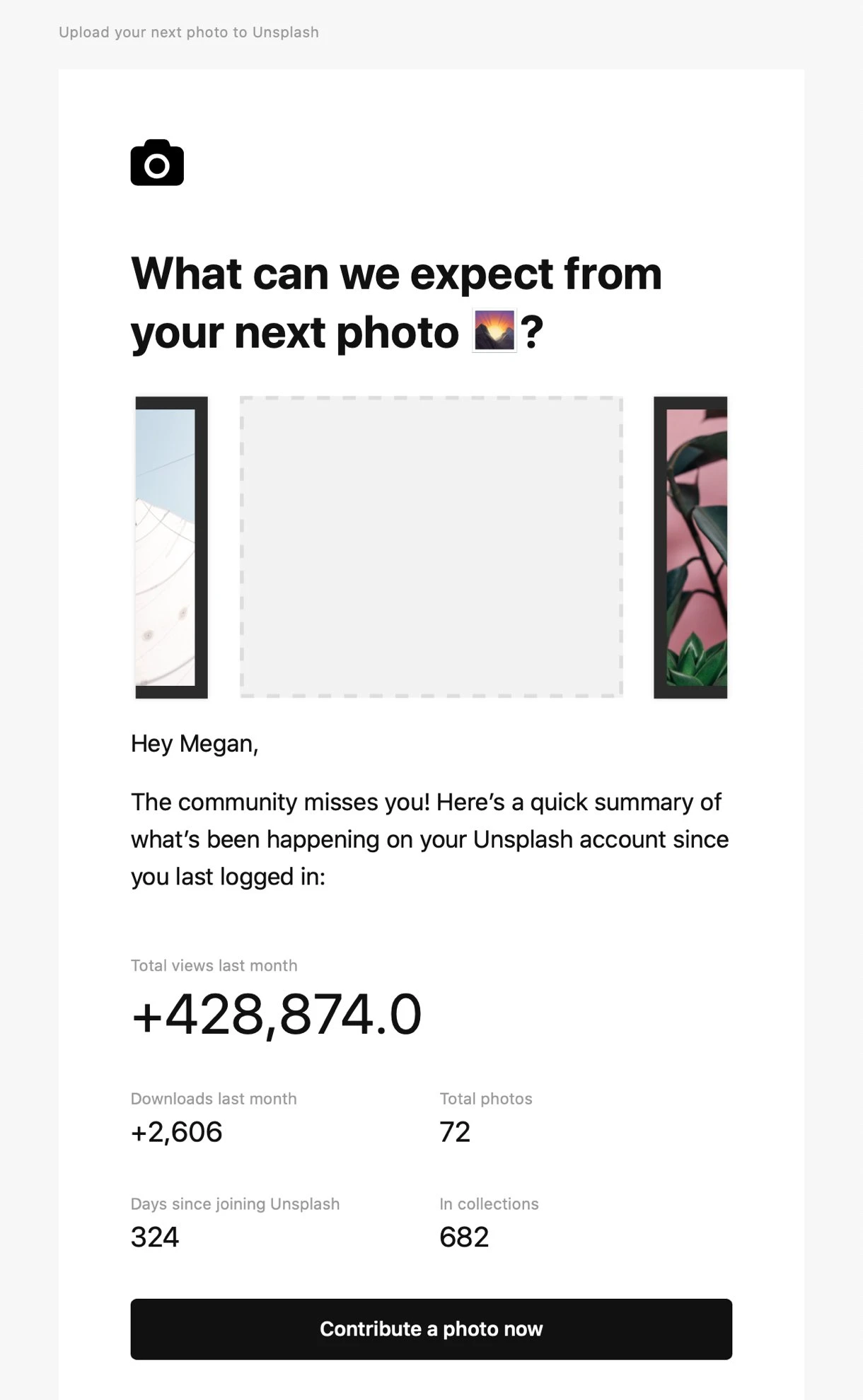
This re-engagement email campaign example from Brooklinen combines a cute image of a dog and playful copy with the promise of new products that the customer won't want to miss out on.
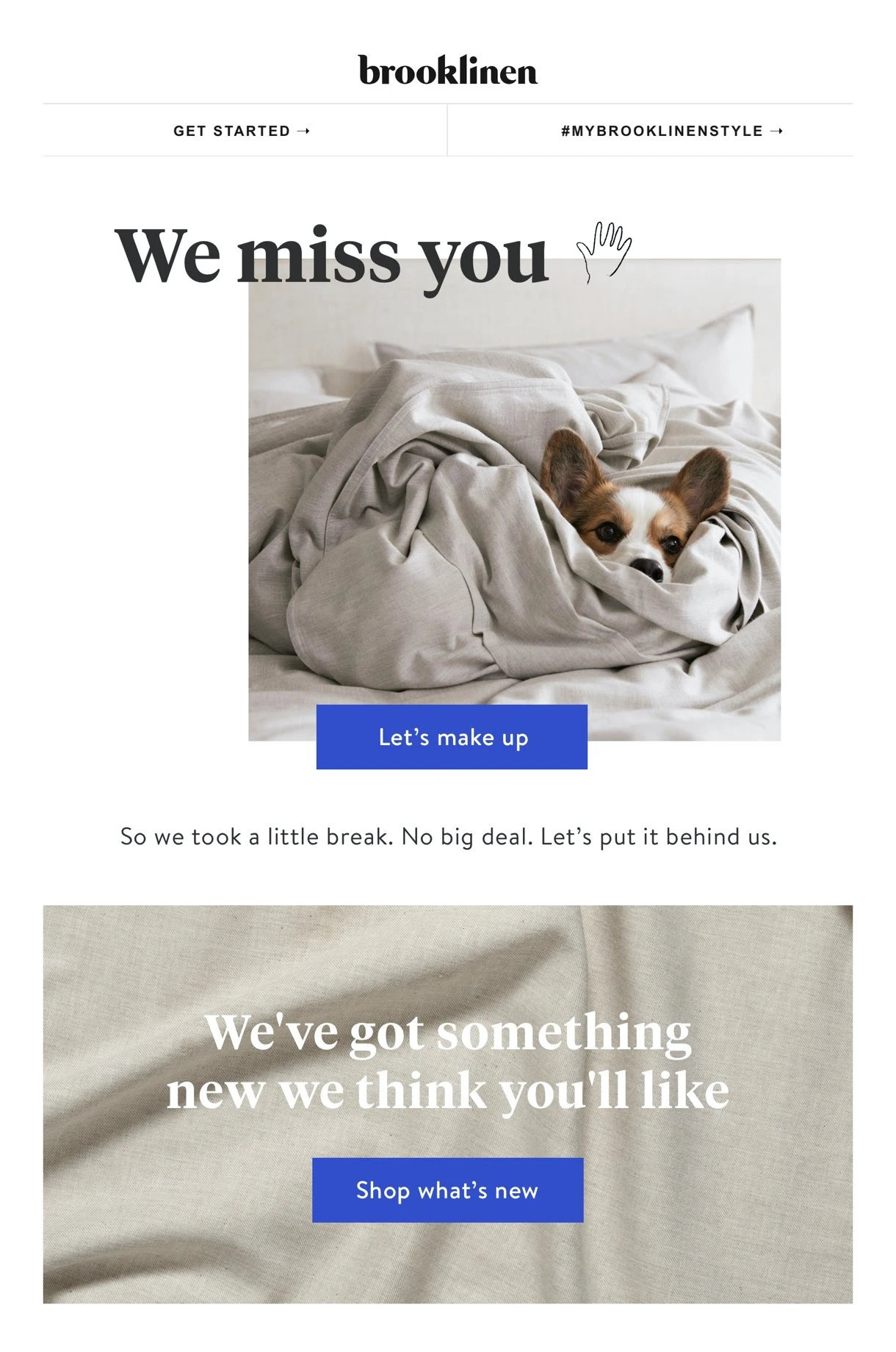
In this example from Dropbox, the business uses the simple subject line “It’s been a while, here’s what’s new at Dropbox” and then provides a summary of the tool’s new features.
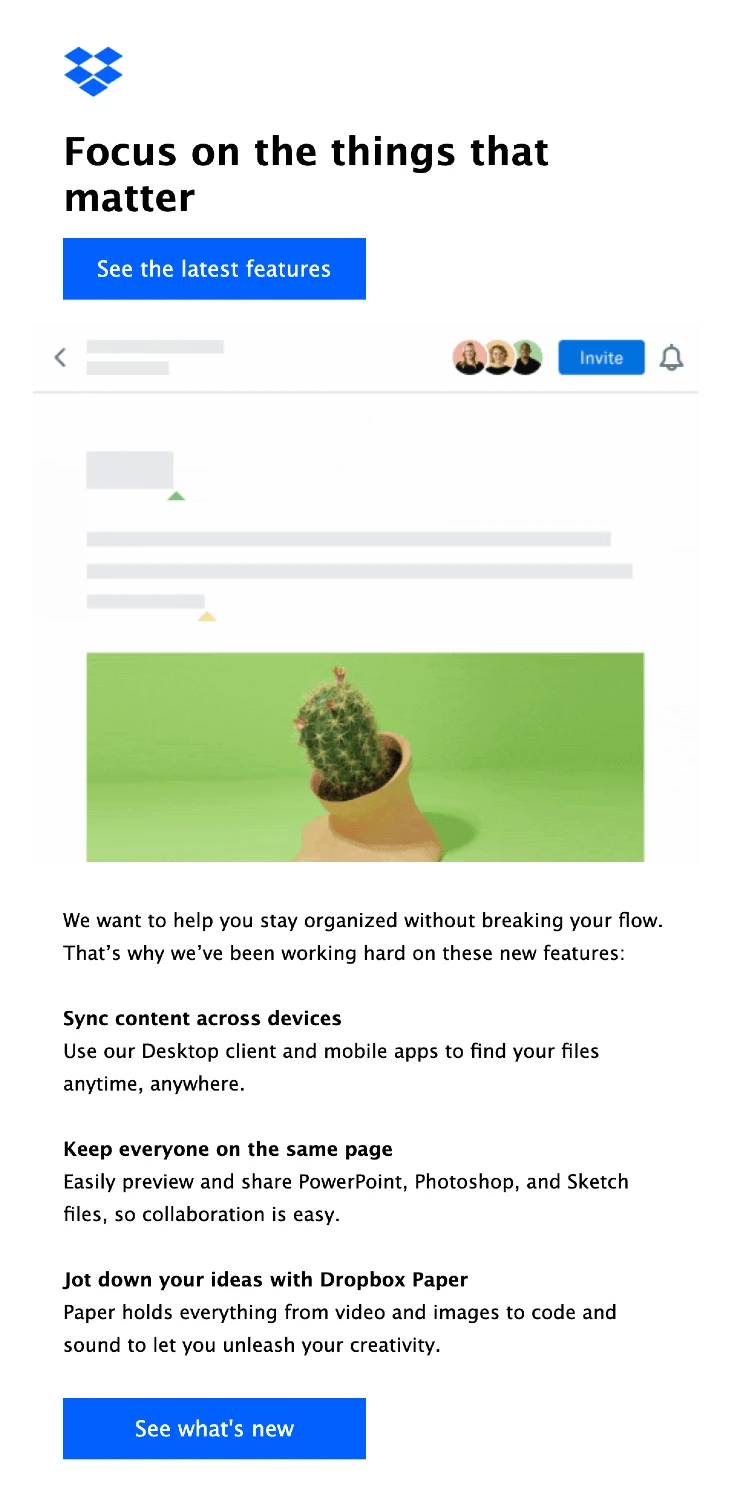
Remind subscribers why they signed up
Not all re-engagement campaigns need a new value proposition. Sometimes it’s better to remind subscribers why they signed up for your list in the first place.
This re-engagement email example from The Verge highlights the value of staying subscribed while making it easy for people who want to leave the list to do so.
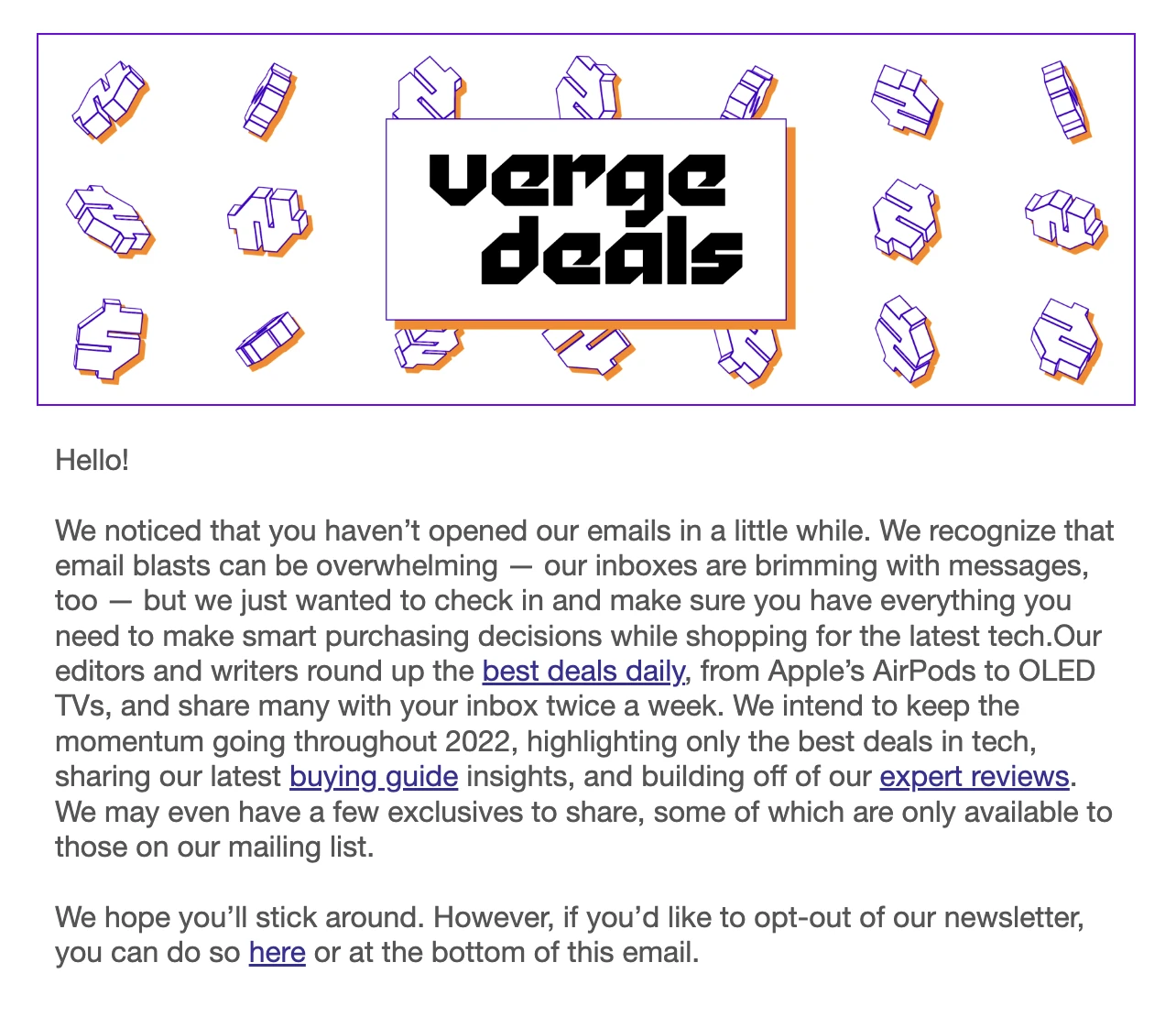
In this re-engagement campaign example, 9 Clouds grabs the reader’s attention with an image of a sad dog and then lists all the benefits of staying subscribed. Even the most unengaged customer will struggle to say no to those sad puppy eyes!
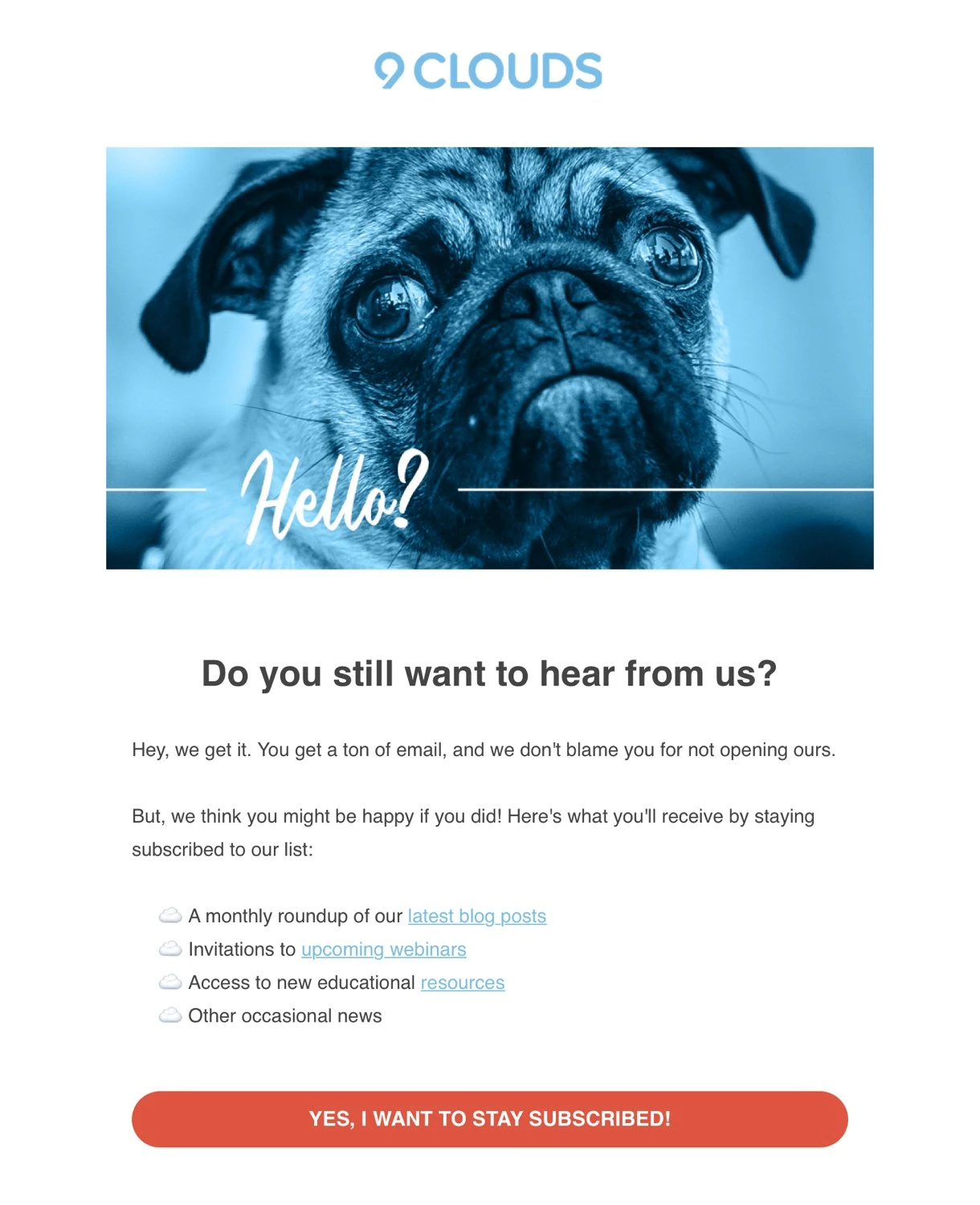
Let people choose which emails to receive
Subscribers may ignore your emails when you send too many about topics they no longer care about. Stop this from happening by letting subscribers choose the type of email and frequency of the content they receive.
The team at Zapier knows that people don't want to receive emails they aren’t interested in. The brand’s re-engagement email contains a link to the preference center so subscribers can choose only to receive relevant content.
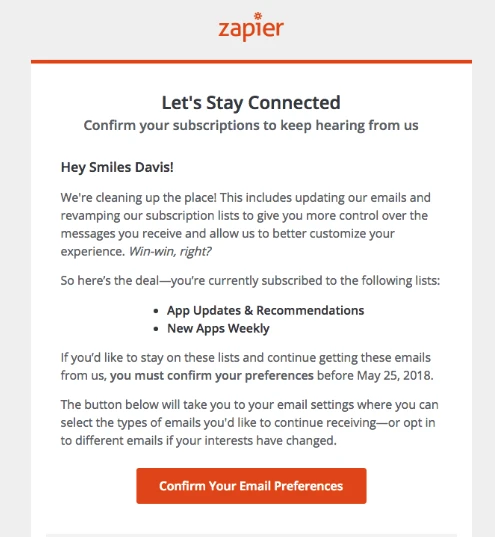
Show customer success stories
Sometimes, the best way to re-engage a subscriber is to show them what other people who use the platform have achieved in the time since they’ve been away.
This re-engagement email example from Adalo highlights 3 case studies that show how other users have built No-Code apps on the platform.
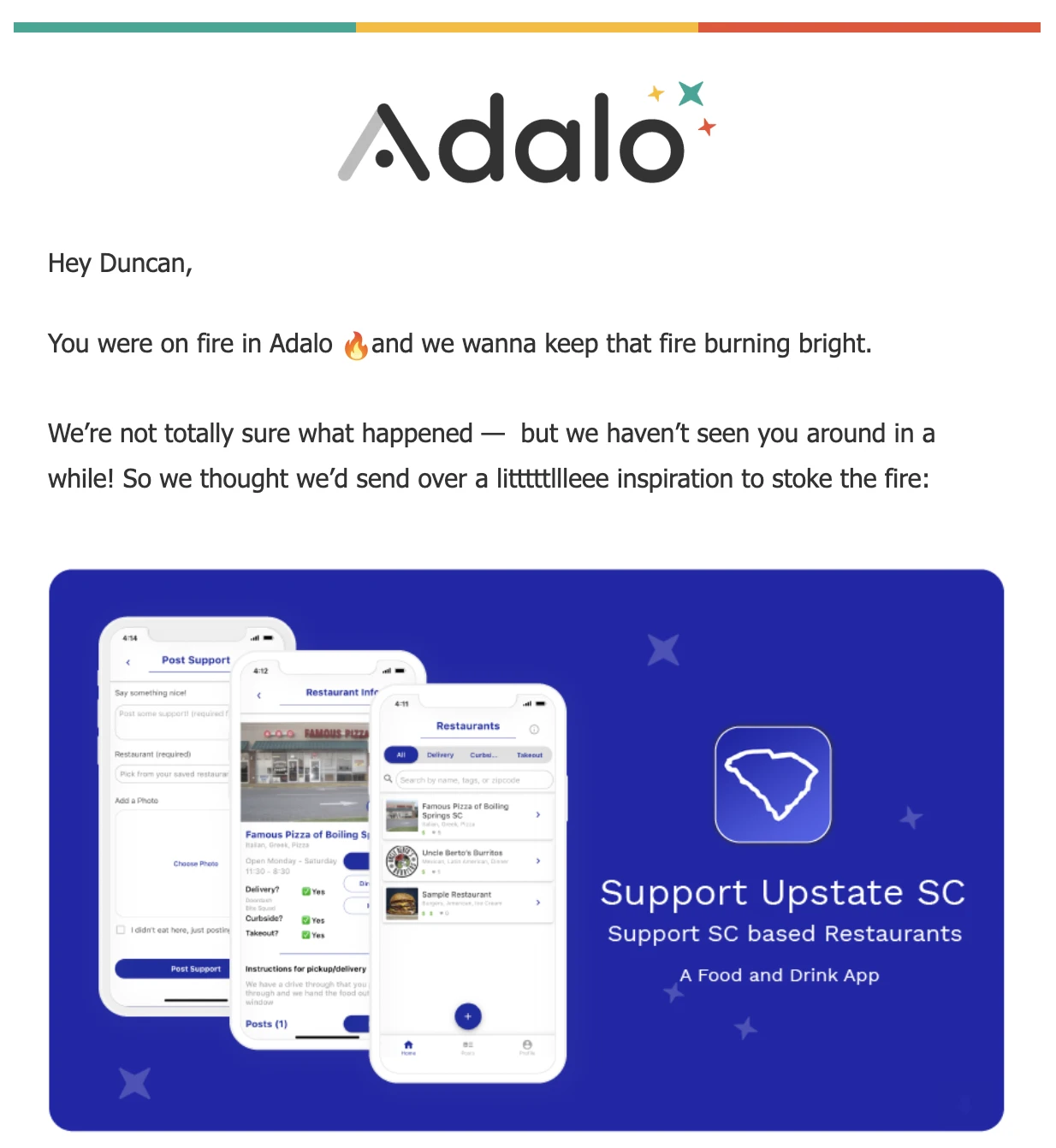
Always follow up
Subscribers who ignore your regular emails may also ignore your re-engagement messages. Get around this by sending multiple messages in a single sequence to increase the chances of people seeing your emails. You can also try out multiple strategies to gain the interest of customers.
Remember the 9 Clouds re-engagement email we highlighted above? The sad dog email wasn't the only email we received from them; they also sent the one below—which has a totally different angle.
Instead of highlighting the benefits of being a subscriber, it reintroduces the brand and highlights its most popular downloadable resource.
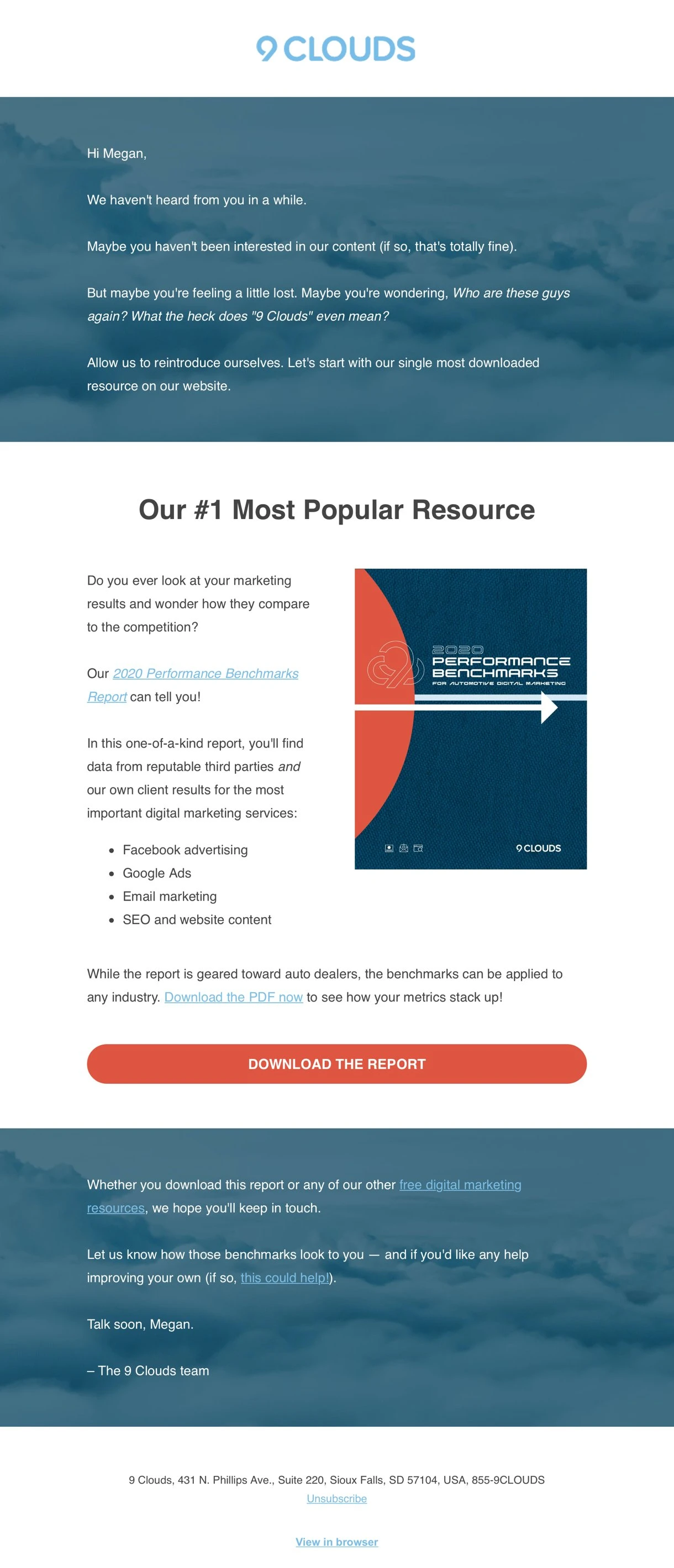
You can either follow up with an email that refers to the previous one, or you can try a couple of different approaches to see what catches the reader's eye.
Give subscribers the chance to leave
While a re-engagement campaign aims to spark the subscriber’s interest, some people simply don’t want to hear from your brand anymore. Make it easy for people to actively decide whether to keep receiving your emails or unsubscribe by adding a “Goodbye” email to your campaign.
Here's how we handled our re-engagement email newsletter campaign at MailerLite. We start by asking subscribers to click a link if they still want to hear from us, then we send a final email letting them know they have been removed from our list while providing one last opportunity to opt-in again.
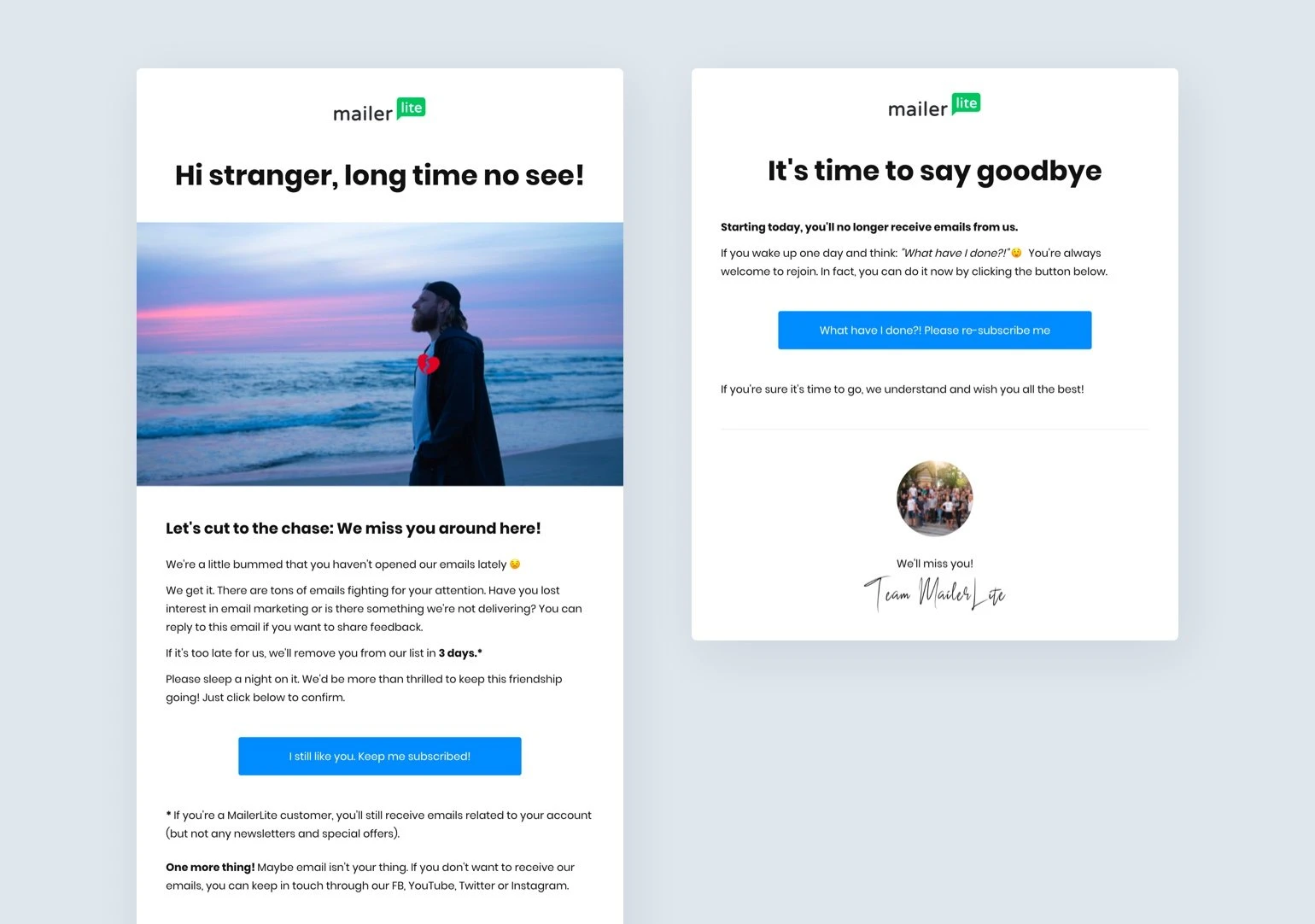
Online clothing retailer Revolve takes a humorous approach using a trope we usually associate with personal relationships: “Was it something we said?” They follow this up with the option to unsubscribe or update their email preferences to receive only the types of emails that are useful to them.
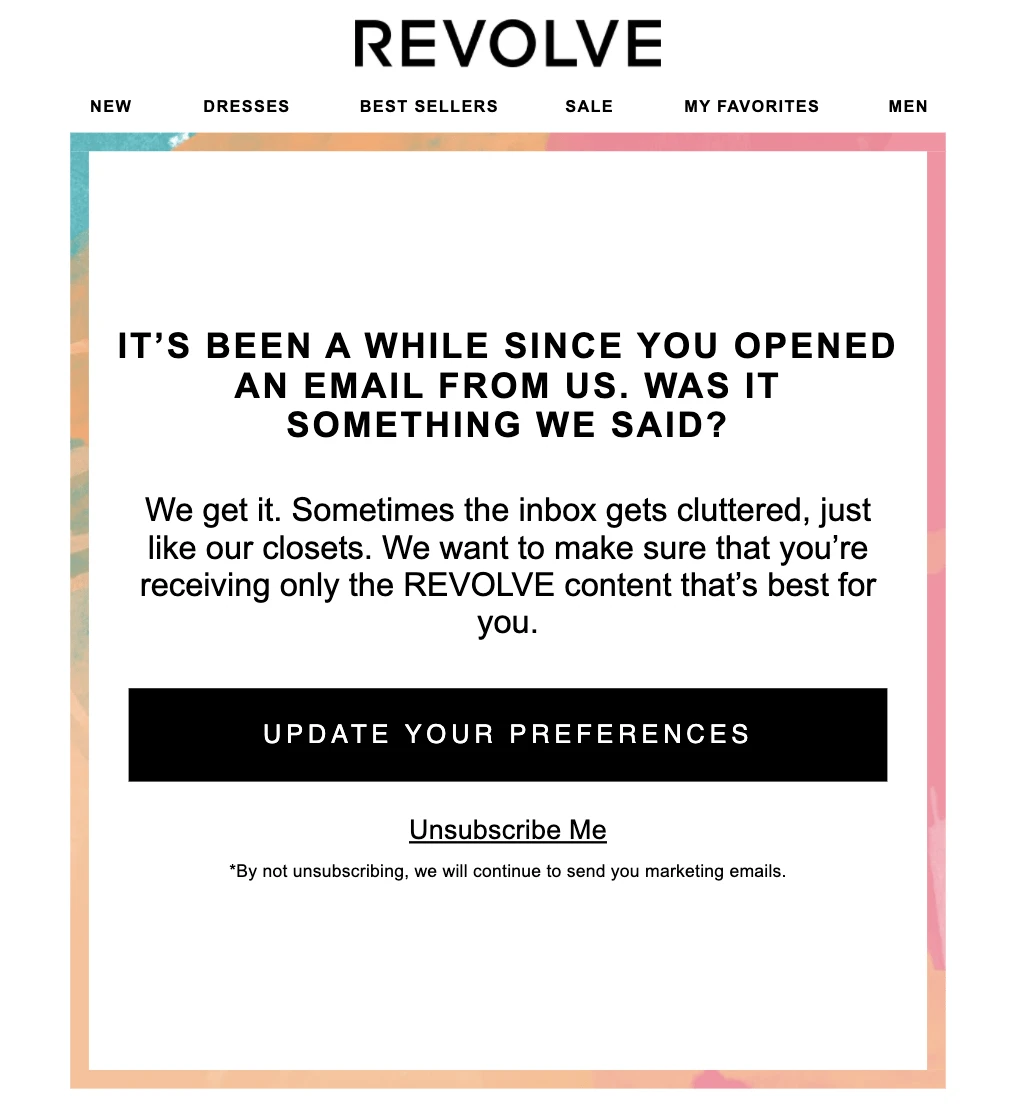
Re-engagement email subject line examples
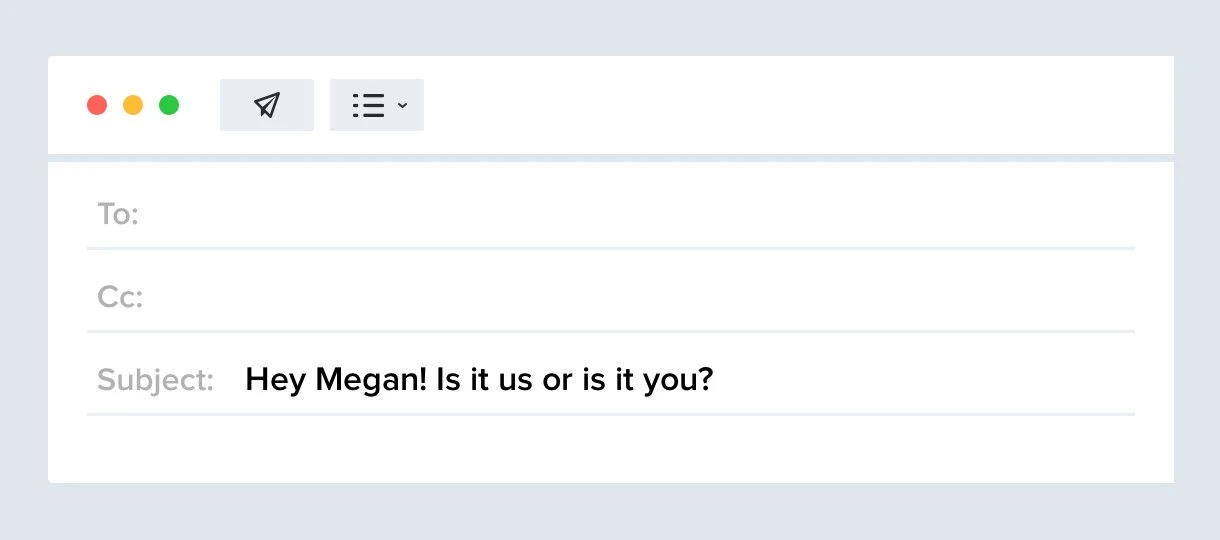
Re-engagement email subject lines are the main tool you have to wake up inactive subscribers. This is your last opportunity to breathe some life into the relationship, so don’t hold back. Experiment and try creative ideas to grab the reader’s attention.
You want the re-engagement email subject line to be completely different from what you usually send so readers will do a double-take. Personalization can help with this!
Some fun examples could be:
Hey [name]! Is it us or is it you?
Be honest with us, we can handle it
Are you missing us? Let’s reconnect
We need to have THE TALK
Hey! Are you still here?
Are we breaking up?
Can we make up?
You've been missing out…
If fun, attention-grabbing subject lines don’t fit your brand or content, you can also go for a more straightforward approach or entice them with an offer:
It’s been a while
$xx off your next purchase
Please come back
We miss you, [name]
Is this goodbye?
Do you still want to hear from us?
Still want to receive my newsletter?
✔✖ Is this your best email address?
Reason #1 to click: $20 OFF
Finally, here are some re-engagement email subject line examples from real campaigns:
[Action Required] Confirm your email preferences (Zapier)
You Still There? (The Verge)
{$name}, We Had a Good Thing Going! (Adalo)
It’s been a while, here’s what’s new at Dropbox (Dropbox)
It’s important to A/B test your subject lines until you find a few that work well for you. When you are happy with the subject line, it’s time to deliver value in your content.
How to create your re-engagement campaign strategy
Here are the exact steps you can take to create a re-engagement campaign with MailerLite. Just head to your account dashboard to follow the steps and start building your campaign. If you don't have an account yet, sign up for free to follow along.
We recommend that you run a re-engagement campaign every 3 to 12 months, depending on how many subscribers join your subscriber list and the number of emails you send.
1. Create a segment for inactive subscribers
First, head to the Subscribers section of your MailerLite Dashboard. Go to Segments and click on Create segment. Name your segment. We’ve named it Inactive subscribers.

Next you choose the filter Time inactive, and select a time period. For example, Time inactive > 30 days would include all subscribers who haven't interacted with your emails in the over 30 days.
The Time inactive period you choose will depend on your business. Businesses that send multiple emails per week will typically choose a shorter time frame than one that only sends a monthly newsletter.
As a guide, at MailerLite we send a weekly newsletter and mark people as inactive when they haven’t interacted with our content in 90 days.
Once you click on the Time inactive, click on Save changes. This will result in a list of subscribers filtered by the condition you choose.

You now have a segment of Inactive subscribers.
2. Create your re-engagement email automation
The next step is to set up your re-engagement automation. Just head to the Automation page on your MailerLite dashboard and then click New automation.
Next, set the Trigger for your automation to Joins a segment and then choose your new Inactive subscribers segment.

When you turn the automation on, you'll be prompted to choose whether or not to add existing segment members to the workflow. Make sure you select the option that triggers the workflow for all segment members.
3. Add your emails
Now your trigger is set up; you can create the emails you’ll use to re-engage your subscribers. Remember to take a look at the reactivation emails in the section above for inspiration.
We recommend sending between 2 and 4 emails in your re-engagement campaign. This gives subscribers plenty of opportunities to see and interact with your emails without overwhelming their inboxes.
Be sure to add a Delay in between each email as this ensures your emails aren’t all sent at once, giving subscribers time to engage with each message. The amount of time you choose is up to you, but 3 days is usually enough time to let people see the message.
Then, add conditions after the delay but before the next email that remove anyone who engages with the workflow’s previous emails. This ensures you don’t annoy re-engaged subscribers by sending them multiple emails.
Do this by choosing Condition, then selecting Workflow activity, the previous email, and then Had any link clicked. You could also choose Was opened, but Apple privacy changes mean that emails sent to Apple Mail are automatically marked as open, whether or not they actually were. This leaves Had any link clicked as the more accurate measure of engagement.
Finally, remove people who did click on the email from the rest of the workflow by adding an Action step, choosing Remove from group and then choosing the group with your inactive subscribers.

MailerLite lets you set up A/B tests in your automations so you can discover which version of a step is is the most effective. This is super useful for re-engagement campaigns as you can test different offers and subject lines to see which does the best job of re-engaging your visitors. Once the test is finished, you can select a winner and roll it out across your entire workflow. Find out more about automation A/B testing here.
4. Unsubscribe non-respondents
After you’ve added your emails, you need to add a final step to unsubscribe anyone who doesn’t interact with your re-engagement campaign.
Do this by adding an Action step after the final email and choosing the option Unsubscribe. Be sure to add a delay step in between the final email and the condition to give the email recipient time to interact with the message.
See how the completed workflow looks in the screenshot below.

Re-engagement automation template
MailerLite customers can access our pre-built re-engagement automation email template. This contains steps you can customize to create a re-engagement campaign.
Use it to create a one-off re-engagement campaign you send out to inactive subscribers. Click here to check out the re-engagement campaign automation template and view the instructions.
Please note: Due to MailerLite updates, you can change the trigger to Joins a segment.
A MailerLite customer’s success story with re-engagement campaigns
Scott Baptie, a best-selling author and founder of the Food For Fitness recipe app, manages a massive list of over 100,000 active subscribers. With a list that big, unengaged users are inevitable, and keeping things clean is non-negotiable for maintaining high deliverability.
Here’s Scott's winning strategy: Instead of just deleting inactive subscribers, Scott first tries to bring them back into the fold with an automated win-back campaign. This gives him one last shot to re-engage them and turn them into app downloads or paying customers.
He targets subscribers who haven't opened any emails in the last 6 months with a powerful, 5-email automated series, by sending 1 email every 2 days.
This strategy effectively saves a significant number of subscribers who might have otherwise been lost! If a subscriber still doesn't open after the 5-email sequence, they are then safely removed from the list.
Read Scott’s success story here:
Stronger engagement is your end goal 🤝
Inactive subscribers are a reality for every email marketer. While a re-engagement campaign might leave you with a smaller list, the remaining active subscribers will be more engaged.
Stronger engagement increases the effectiveness of your email newsletter campaigns, improves your sender reputation, and leaves you with a more accurate view of what's working and what's not. That is where you want to be!

